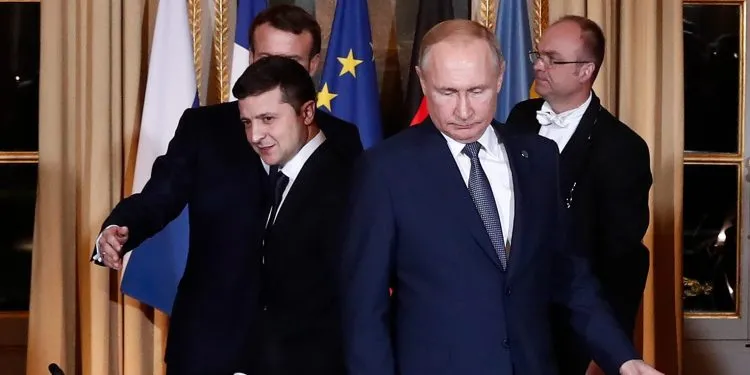The stakes in the Ukraine-Russia war have reached new heights, with key developments in the past week pointing to the growing global significance of the conflict. As the war entered its 1,000th day, both Western powers and the Kremlin significantly raised the stakes, signalling an intensifying battle for control of the narrative and the military advantage.
US and UK increase Support for Ukraine
In a decisive move, outgoing U.S. President Joe Biden authorised Ukraine to use longer-range ATACMS missiles to strike targets inside Russian territory. This marked a major shift in U.S. policy, as Washington had previously resisted Ukraine’s requests to use the missiles beyond its own borders.
Soon after the announcement, Ukraine fired a series of ATACMS missiles into Russia’s Bryansk region. The Kremlin reported that six missiles were launched with five intercepted, while U.S. officials claimed that eight missiles were fired with two intercepted. Regardless of the exact numbers, this marked the first time that American-made missiles had struck Russian soil during the war.
The escalation continued with Ukraine launching UK-supplied Storm Shadow missiles at Russian targets in the Kursk region on Wednesday. Ukrainian troops have gained control of a 600-square-kilometer patch of Russian territory there, further intensifying the pressure on Moscow.
Later in the week, Biden approved the use of anti-personnel landmines for Ukraine’s defence on the eastern frontlines. While controversial, these landmines are seen as a highly effective tool for slowing Russia’s advance, signalling a clear commitment by the West to continue its support for Ukraine.
In a matter of days, the West’s military support for Ukraine had ramped up significantly, sending a clear message that its backing would not waver in the face of Russia’s escalating threats.
Russia Increases Threats
As Western powers increased their support for Ukraine, Russia responded with its own heightened rhetoric and military actions. On Tuesday, marking the 1,000th day of the war, Russian President Vladimir Putin pushed through changes to the country’s nuclear doctrine. Under the new policy, an attack on Russia from a non-nuclear state, if backed by a nuclear power, would be treated as a joint assault on Russia.
Russia also deployed its newly developed “Oreshnik” missile, which Putin claimed travels at ten times the speed of sound. He further stated that there are “no ways of counteracting this weapon.” The missile strike on the Ukrainian city of Dnipro clearly demonstrated Russia’s technological advancements. Many analysts believe it primarily aimed to send a message: Russia could use the missile to deliver a nuclear payload if it chose to do so.
Russia’s nuclear threats have become a familiar part of the war’s rhetoric yet the West remains unshaken. Western nations have crossed Putin’s repeated nuclear “red lines” throughout the conflict, and many increasingly doubt his willingness to escalate to nuclear war, especially with China as a crucial partner to Moscow. The West sees Beijing reacting strongly to any nuclear escalation, which deters Putin from crossing that threshold.
A Global Conflict in the Making?
On Thursday, Putin raised the spectre of a global conflict, warning that the war had “acquired elements of a global character.” Polish Prime Minister Donald Tusk echoed this view, calling the threat of a global conflict “serious and real.” The U.S. and U.K. engage more deeply than ever, while North Korean troops deploy alongside Russian forces, bringing another nuclear power into the fray.
North Korean leader Kim Jong Un, in a rare statement on Thursday, warned that the threat of nuclear war had never been greater, blaming the U.S. for its “aggressive and hostile” policies toward Pyongyang. Reports suggest that North Korean soldiers are fighting alongside Russian troops in the Kursk region, adding a new layer of complexity to the conflict.
Trump’s Imminent Return and What It Means for Ukraine
Why are these developments occurring now? One major factor is the looming arrival of U.S. President-elect Donald Trump, who will take office in January. On the campaign trail, Trump vowed to end the Ukraine-Russia war within “24 hours,” and his team has suggested that such an end would likely involve compromises for Ukraine, including ceding territory in the Donbas and Crimea.
This stance sharply contrasts with that of the Biden administration, which, as seen in the past week, is pushing to provide Ukraine with as much support as possible before Trump’s arrival. Despite this, some see Trump’s return as potentially beneficial for Ukraine.
Ukrainian President Volodymyr Zelensky has suggested that the war could end “sooner” under Trump, although the specifics remain unclear. Former Ukrainian foreign minister Dmytro Kuleba told the BBC that Trump’s leadership would be driven by a desire to project strength and to rectify what he sees as past failures, particularly the U.S.’s handling of Afghanistan. He warned, however, that if Trump were to follow through on his possible compromises, the situation could become Ukraine’s equivalent of the U.S. withdrawal from Afghanistan, with significant consequences for American foreign policy.
The Battle for the Best Negotiating Position
The events of this week have set the stage for a larger struggle over the best negotiating position for both sides as the war drags on. While it may not be the start of a runaway escalation, it signals that both Ukraine and Russia, along with their global allies, are preparing for a long-term conflict. As the Ukraine-Russia war’s 1,000th day passed, the world now faces a heightened danger of a broader, more protracted war, with the potential for further nuclear threats and global instability.



